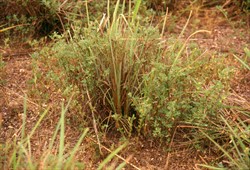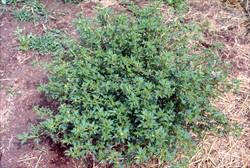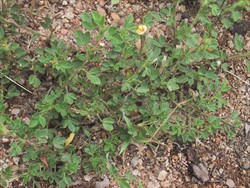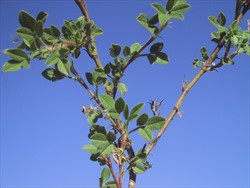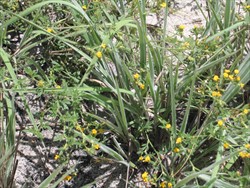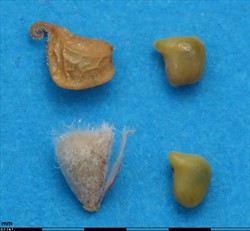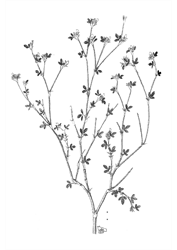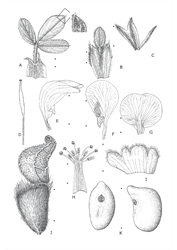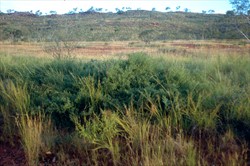Stylosanthes viscosa
Tropical Forages
Stylosanthes viscosa (L.) Sw.
Basionym: Hedysarum hamatum var. viscosum L.; Stylosanthes glutinosa Kunth; Stylosanthes prostrata M.E. Jones
Family: Fabaceae (alt. Leguminosae) subfamily: Faboideae tribe: Dalbergieae subtribe: Stylosanthinae.
Erect, ascending, spreading, much branched, perennial herb to subshrub, 15‒50 (‒100) cm tall. Stems woody at the base, upper branches herbaceous, with short, tuberculate bristles and densely pubescent with short viscid hairs, prostrate when cut or grazed in young stage. Leaves trifoliolate; stipules amplexicaul, viscid, densely pubescent and with tuberculate bristles; sheath 3.5‒7.3 mm long; teeth needle-like, 1‒5.7 mm long; petioles 2.5‒5.0 mm long, hispidulous, viscid, rachis 1‒2 mm long; leaflet blades ovate, obovate-elliptic to lanceolate, 6‒14 (‒25) mm long and 3‒5 (‒8) mm wide, both sides densely pubescent, short bristles, apex acute or obtuse. Inflorescence a small (6‒11 mm long), terminal or axillary, crowded, viscid ovoid spike with 2‒5 (‒8) flowers; primary bracts unifoliolate or trifoliolate, with tuberculate bristles and silky pubescence. Flowers with suborbicular standard 4‒7 mm long, yellow with a dark red striation forming an arch; wings 4‒5 mm long, auriculate, keel 3‒4 mm long, falcate. Pod (loment) comprising two fertile articles 1.5‒2.5 mm long, 1.4‒2 mm wide, shortly hairy, reticulately nerved; beak on terminal articulation 0.5‒0.9 mm long, mostly coiled. Seed cream-coloured to light brown, smooth, 1.4‒1.7 × 0.8‒1 mm, similar size to that of S. scabra. 400,000‒500,000 seeds-in-pod and 600,000‒800,000 dehulled seeds per kg.
Three ecotypes are recognized in Brazil:
1) Prostrate, densely hairy type with small leaves and inflorescences from Rio de Janeiro, Espirito Santo, and very dry caatinga area of Bahia.
2) Erect leafy type with small spikes, and anthocyanin in leaves, from western Minas Gerais.
3) Prostrate type, with large leaflets (no anthocyanin), and thick stems from southern and south-western Minas Gerais - most susceptible to anthracnose.
Similar species
S. viscosa: no axis rudiment
S. scabra: axis rudiment present
Africa: moritaba (Bambara, West Africa); bala korama, bâda gotur (Senegal); damel, mbono muso, nbono (The Gambia)
English: sticky stylo (Australia); poor man's friend (Jamaica); viscid pencil-flower (USA); false lupine
Latin America: alfafa do nordeste, meladinha, meladinha-de-cavalo, melosa, vassourinha (Brazil), comino sabanero (Cuba); hierba del pujo (Mexico)
Note: Many of the African names may (also) refer to Stylosanthes fruticosa (Retz.) Alston
Native:
Northern America: USA (Texas (s.)); Mexico (Baja Sur, Campeche, Chiapas, Colima, Guerrero, Jalisco, Nayarit, Oaxaca, Sinaloa, Sonora, Tabasco, Zacatecas (s.))
Central America: Belize; Costa Rica; Honduras; Nicaragua; Panama
Caribbean: Cuba; Dominican Republic; Jamaica
South America: Argentina (Chaco); Bolivia; Brazil (Bahia, Mato Grosso do Sul, Minas Gerais, São Paulo); Colombia; French Guiana; Guyana; Paraguay; Suriname; Venezuela (Bolívar, Mérida, Zulia, Anzoátegui, Barinas, Falcón, Monagas, Nueva Esparta, Sucre, Trujillo)
Naturalized:
Africa: Sierra Leone; Upper Guinea (possibly misidentified S. fruticosa)
Asia: India (Tamil Nadu)
Australasia: Australia (Western Australia, Northern Territory, northern Queensland)
Pacific: Hawaii
Forage
S. viscosa has not been evaluated widely but may have a role in reducing tick populations (order Acarina) in grazing lands. Generally considered too unpalatable to be successful in evaluations, but there may be more palatable and anthracnose resistant types should the need arise.
Other
Soil requirement
Occurs on soils with pH from 4 to 7.5 (mostly acid), often on very sandy or sandy loam soils of sedimentary or granitic origin, but also on clays and clay loams. Soils are generally well drained. Tolerant of high soil Al+++ levels.
Moisture
Average rainfall at collection sites varies from 230 mm in Baja California, Mexico, to 3,200 mm in Cayenne, French Guiana, often with long dry seasons. Most accessions have been collected from sub-humid sites receiving 1,000‒1,750 mm rain per year, with a 4‒5 month dry season. High level of drought tolerance, comparable with that of S. scabra. Generally intolerant of waterlogging, particularly ecotypes from semi-arid tropics.
Temperature
Tropical to warm subtropical in distribution, from 29° S to 29° N, and from sea level to 2,000 m asl. Ecotypic differences in frost tolerance.
Light
Occurs mostly in open scrub, woodland or open, rocky savanna, usually in fully exposed positions, suggesting low tolerance of shading.
Reproductive development
At about 20º S, flowering commences from late February/early March to late May depending on ecotype.
Defoliation
Tolerant of heavy grazing, although grazing pressure often modified through low palatability of S. viscosa herbage.
Fire
Fire tolerance varies with ecotype (e.g. CPI 34904 susceptible, CPI 38611 tolerant).
Guidelines for establishment and management of sown forages.
Establishment
Embryo dormancy in fresh seed declines rapidly. The main restriction to germination is hard seededness, which is often high in freshly harvested seed. Natural breakdown of hard seededness is brought about by exposure to soil surface temperatures of 50‒55 ºC. In the seasonally dry tropics, dry season soil surface temperatures are sufficient to soften seed in readiness for the first rains. When rapid germination and establishment of a proportion of the seed is desirable, various scarification treatments have been developed, often involving dry heat. Recommendations vary from 1‒2 hours at 85 ºC in a heated oven, to 15‒30 seconds on a hot surface at 140‒150 ºC, in each case cooling to ambient temperature. Since heat treatments can damage seed, the safest and most practical way of scarifying seed is to use a hammer mill, which de-hulls and scarifies about 50% of the seed. Seed is sown at 1‒2 kg/ha. Seedlings tend to be weak and slow growing during the first season. Inoculation is not essential since S. viscosa nodulates readily with a wide spectrum of rhizobium strains, but use of CB 82 or CB 756, strains proven effective on this species, provides a measure of insurance.
Fertilizer
While able to establish and persist on low phosphate soils, S. viscosa responds to applications of 10‒20 kg/ha P on such soils. This is of benefit to both plant and animal.
Compatibility (with other species)
Once established, S. viscosa can persist with many of the grasses that grow in the same environment. Also competes with many lower-growing weed species, but not with taller-growing, unpalatable species.
Companion species
Grasses: Cenchrus ciliaris, Digitaria milanjiana, Heteropogon contortus, Urochloa mosambicensis.
Legumes: Aeschynomene americana, Chamaecrista rotundifolia, Stylosanthes hamata, S. guianensis var. intermedia, S. scabra.
Pests and diseases
Susceptibility to anthracnose caused by Colletotrichum gloeosporioides varies from highly susceptible to resistant, depending on genotype. Fifty-six per cent of accessions tested were resistant to a mixture of races 1 and 2 of Type A of the organism. Susceptible to blight caused by Sclerotium rolfsii as are many plant species. Slightly affected by legume little leaf phytoplasma, but possibly not as severely as is S. scabra. Some resistance to root knot nematode (Meloidogyne javanica), e.g. CPI 38611.
Ability to spread
Capable of spreading from plots.
Weed potential
S. viscosa appears in weed lists of several countries, but at this stage (2018) it is not considered a major weed. The ability to set seed and the low palatability of herbage, combined with the ability to survive dry conditions in poor soils confer weed potential on some accessions.
Nutritive value
CP and P levels of mature herbage range from 6 to 2%, and 0.05 to 0.13% P, respectively.
Palatability/acceptability
Generally considered unpalatable. Low palatability compared with Centrosema acutifolium, Desmodium velutinum and Zornia glabra.
Toxicity
No record of toxicity.
Dry matter
Generally not as productive as S. scabra. Yields of 4.9 t/ha DM have been recorded in the first year and 12.5 t/ha DM in the second year.
Animal production
Appears to have little benefit to animal production.
2n = 20. Sporadic inter-specific crosses occur. Evidence suggests that S. viscosa is the maternal parent of the allotetraploid, S. scabra, with S. seabrana the pollen parent.
Seed production is difficult with this species due to the sticky nature of the inflorescence, leaves and stems. The viscid substance, which is soluble in organic solvents but not water, is difficult to remove from equipment used in the harvesting process.
Probably similar to S. scabra.
- Drought tolerant.
- Grows on poor soils.
- Persistent.
- Some resistance to anthracnose.
- Acaricidal properties.
- Sticky/viscous.
- Unpalatable.
- Susceptible to waterlogging.
- Little benefit to animal production.
Keller-Grein, G. and Schultze-Kraft, R. (1992) Preliminary agronomic evaluation of a Stylosanthes viscosa Sw. collection. Genetic Resources Communication No. 15. CSIRO Tropical Agriculture, St Lucia, Australia.
Stace, H.M. and Edye, L.A. (eds) (1984) The biology and agronomy of Stylosanthes. Academic Press, Sydney, Australia. doi.org/10.1016/B978-0-12-661680-4.X5001-X
None released to date.
JCU-Vs1 Selected in Queensland, Australia. Accepted for PBR protection 22 May, 2018.
